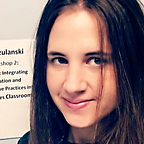The sound ripples like a playful wave throughout the room — giggles, gurgles, and guffaws of children — about 80 of them — aged 2 through 10 — sitting together in a room, and enjoying a movie. After a full morning of play, davening, and creating beautiful art for bags going to the Bronx Jewish Community Council food pantry, children with full bellies sat together as a community, brought together by their shared attendance of the program, and by the robust guidance of their youth leaders.
I happened to be in the room when the laughter reached a crescendo, and turned to our Rabbi — who was also in the room — and said “this beautiful sound is so needed — especially today”.
Some of the most challenging imagery of Megillat Eicha — The Book of Lamentations — which we read on Tisha B’ Av, concerns children. Echoes of the cries of starving, pleading, and dying children echo throughout the haunting poetic language of Eicha. We read of pillaging and destruction beyond our imaginations, and are forced to hear the screams of terror and despair as we remember — yet again — the destruction of our home, and with it our hope for a future for The Jewish People.
When you ask children today why the grownups in their lives fast on Tisha B’ Av, the answer — apart from the telling of the destruction of The Temple — is that the grownups have to be sad. Full bellies and nutrient rich blood signifies joy — and empty bellies and scarcity signifies despair — even children know it. Children, especially those who have had conversations in schools, camps, or their homes about the meaning of Tisha B’ Av are well versed in its purpose, and grounded in the reality that today — their grownups are sad. Some children, in conversation, may also share that sometimes their grownups are sad when it is not Tisha B’ Av.
The morning of Tisha B’ Av programming is the same each year — anxious parents leaving curious kids for the day in a program that, they hope, will be meaningful. As the day ebbs and flows, we — meaning me and my indispensable team of youth leaders (aged 12–18) — create and hold a container for these children so that they can safely spend a day in community, while their grownups are in sadness.
The children come together with an understanding — today we will play, we will spend the day, and we will find new ways to work together. They know that there will be games, and many snacks, and some fun activities. They know that they are expected to share, and try, and listen. They know so many things- and still. -year after year, what they realize by the end of the program, is that they are actually rebuilding.
On Tisha B’ Av we remember the destruction of The First and Second Temples. We hold ancestral destruction in our hearts, all the while knowing deeply that real destruction is still happening — today — in our world. In our many homes in the diaspora, and in our home in Israel — we know that the world is still crying out for salvation. We — grownups — spend the day on the floor, reading lamentations and dirges, and mourning. Some of us grieve for losses too fresh to speak about, and many of us do for those already deep within our souls. Some of us hold pain now in our bodies, our spirits, our minds — many of us don’t speak of it.
While we mourn, our children rebuild.
In a nondescript community room, the children come together and share, listen, play, draw, create, sing out prayers, and laugh — so much — as they build — moment by moment the foundation of our future. When our children laugh — we know that we continue — that life goes on with The Jewish People, and that hope is awake within the young generations. When youth leaders, who are still children, see themselves as leaders, caretakers, and mentors — they add another layer to that building. When the children — as little as 2, and as old as 10 — find new and creative ways to play together — they are engineering the teamwork of their future.
When parents come to pick up their children at the end of the program — many of them will ask me how I am doing? (or — how I did it!?). I tell them that I am doing great, and then wave my hands to indicate the incredible children — youth leaders and kids — who are the heart and soul of our rebuilding. The day is hard. We are asked to look at scars that are still healing -some still fresh. We are beckoned to grieve.
Yet — through it all — there is the laughter of children, and the sounds of rebuilding, wafting through the air.
